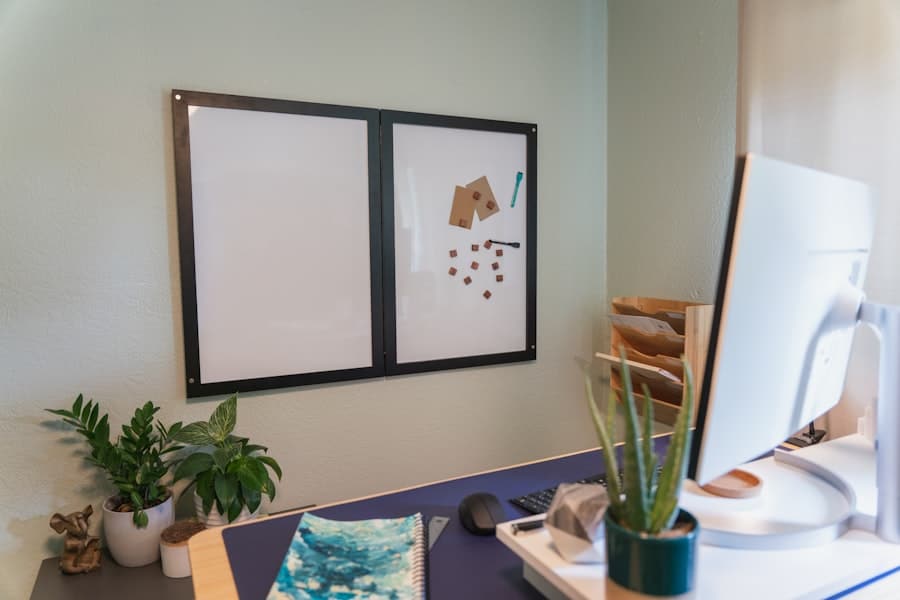Digital whiteboards have emerged as a transformative tool in the realm of hybrid learning, where traditional classroom settings blend with online education. One of the most significant benefits of digital whiteboards is their ability to facilitate real-time collaboration among students and teachers, regardless of their physical location. In a hybrid learning environment, where some students may be attending classes in person while others participate remotely, digital whiteboards serve as a central hub for sharing ideas, notes, and resources.
This technology allows for seamless interaction, enabling all participants to contribute to discussions and activities simultaneously. For instance, a teacher can pose a question on the digital whiteboard, and students can respond in real-time, fostering an inclusive atmosphere that encourages participation from both in-person and remote learners. Moreover, digital whiteboards enhance the overall learning experience by providing a dynamic platform for visual learning.
They support various multimedia formats, allowing educators to incorporate videos, images, and interactive elements into their lessons. This versatility caters to diverse learning preferences and helps to maintain student interest. For example, a science teacher might use a digital whiteboard to display a video of a chemical reaction while annotating key points in real-time.
This multi-sensory approach not only aids comprehension but also makes learning more engaging and memorable. The ability to save and share these sessions further extends the benefits of digital whiteboards, as students can revisit the material at their convenience, reinforcing their understanding.
Key Takeaways
- Digital whiteboards in hybrid learning offer flexibility and accessibility for both in-person and remote students.
- They enhance student engagement by providing interactive and visual learning experiences.
- Digital whiteboards facilitate collaborative learning by allowing students to work together in real-time, regardless of their location.
- Integrating digital whiteboards with virtual learning platforms creates a seamless and integrated learning environment.
- Customizing digital whiteboards for different learning styles ensures that all students can benefit from the technology.
How Digital Whiteboards Enhance Student Engagement
Student engagement is a critical factor in the success of any educational endeavor, and digital whiteboards play a pivotal role in fostering this engagement in hybrid learning environments. By incorporating interactive features such as polls, quizzes, and brainstorming sessions directly into the digital whiteboard, educators can create an immersive learning experience that captivates students’ attention. For instance, during a history lesson, a teacher might use a digital whiteboard to conduct a live poll on students’ opinions regarding a historical event.
This immediate feedback not only encourages participation but also stimulates critical thinking as students consider their peers’ perspectives. Additionally, the visual nature of digital whiteboards can significantly enhance student engagement. Traditional whiteboards often limit teachers to text and static images; however, digital whiteboards allow for the integration of animations, diagrams, and other visual aids that can make complex concepts more accessible.
For example, in a mathematics class, a teacher could illustrate geometric transformations using animated graphics on the digital whiteboard. This visual representation helps students grasp abstract concepts more effectively and keeps them engaged throughout the lesson. Furthermore, the ability for students to interact with the content—by drawing, highlighting, or adding notes—empowers them to take ownership of their learning process.
The Role of Digital Whiteboards in Collaborative Learning

Collaboration is at the heart of effective learning, and digital whiteboards are instrumental in promoting collaborative learning experiences in hybrid classrooms. These platforms enable students to work together on projects and assignments in real-time, regardless of their physical location. For instance, during a group project on environmental science, students can collectively brainstorm ideas on a digital whiteboard while sharing relevant research links and resources.
This collaborative approach not only enhances their understanding of the subject matter but also fosters essential teamwork skills that are vital in today’s interconnected world. Moreover, digital whiteboards facilitate peer-to-peer learning by allowing students to present their ideas and receive constructive feedback from their classmates. In a language arts class, for example, students can use the digital whiteboard to share their written work and engage in peer review sessions.
As they annotate each other’s work directly on the board, they learn from one another’s perspectives and improve their writing skills through collaborative critique. This interactive process not only deepens their understanding of the material but also builds a sense of community among learners, which is particularly important in hybrid settings where social interaction may be limited.
Integrating Digital Whiteboards with Virtual Learning Platforms
The integration of digital whiteboards with virtual learning platforms is essential for maximizing their effectiveness in hybrid learning environments. Many educational institutions utilize platforms such as Google Classroom or Microsoft Teams, which can seamlessly incorporate digital whiteboards into their existing frameworks. This integration allows educators to create a cohesive learning experience where all resources are easily accessible in one place.
For instance, teachers can schedule live sessions on these platforms while simultaneously using digital whiteboards to present lessons and facilitate discussions. Furthermore, integrating digital whiteboards with virtual learning platforms enhances the functionality of both tools. Educators can record sessions conducted on the digital whiteboard and upload them directly to the virtual platform for later access by students who may have missed the live session.
This feature not only supports asynchronous learning but also ensures that all students have equal access to instructional materials. Additionally, many virtual learning platforms offer analytics tools that allow teachers to track student engagement and participation during sessions held on digital whiteboards. This data can inform instructional strategies and help educators tailor their approaches to meet the needs of diverse learners.
Customizing Digital Whiteboards for Different Learning Styles
One of the most compelling advantages of digital whiteboards is their adaptability to various learning styles. Educators can customize content on these platforms to cater to visual, auditory, and kinesthetic learners alike. For instance, visual learners benefit from colorful diagrams and infographics that can be easily created and manipulated on a digital whiteboard.
In contrast, auditory learners may thrive when teachers incorporate audio clips or verbal explanations alongside visual elements. By combining these different modalities within a single lesson, educators can create an inclusive environment that addresses the unique needs of each student. Moreover, kinesthetic learners can engage with digital whiteboards through interactive activities that require movement or hands-on participation.
For example, teachers can design drag-and-drop exercises where students physically manipulate elements on the board to solve problems or complete tasks. This tactile interaction not only reinforces learning but also keeps students actively involved in the lesson. By recognizing and accommodating different learning styles through customized digital whiteboard activities, educators can enhance student comprehension and retention while fostering a more engaging classroom atmosphere.
The Impact of Digital Whiteboards on Teacher-Student Interaction

Digital whiteboards significantly enhance teacher-student interaction by providing dynamic tools for communication and feedback. In traditional classrooms, interactions may be limited to verbal exchanges or written notes; however, digital whiteboards allow for more immediate and visual forms of communication. For instance, during a math lesson, a teacher can pose a problem on the board and invite students to solve it collaboratively.
As students work through the problem together, the teacher can provide real-time feedback by annotating their thought processes directly on the board. This immediate interaction fosters a more responsive teaching approach that addresses student needs as they arise. Additionally, digital whiteboards facilitate personalized instruction by enabling teachers to tailor their interactions based on individual student performance.
Educators can monitor student contributions during collaborative activities and identify those who may need additional support or challenge. For example, if certain students consistently excel in discussions while others struggle to engage, teachers can adjust their strategies accordingly—perhaps by pairing stronger students with those who need more guidance or by providing targeted resources for improvement. This level of interaction not only enhances student learning outcomes but also strengthens the teacher-student relationship by demonstrating attentiveness to individual needs.
Overcoming Challenges with Digital Whiteboards in Hybrid Learning
While digital whiteboards offer numerous benefits in hybrid learning environments, they are not without challenges. One significant hurdle is ensuring that all students have equal access to technology and reliable internet connections.
To address this challenge, schools must prioritize equitable access by providing necessary resources such as laptops or tablets and ensuring robust internet connectivity for all students. Another challenge lies in the training and professional development required for educators to effectively utilize digital whiteboards in their teaching practices. Many teachers may feel overwhelmed by the technology or unsure how to integrate it into their lessons meaningfully.
To overcome this barrier, schools should invest in comprehensive training programs that equip educators with the skills needed to leverage digital whiteboards effectively. Ongoing support from tech specialists or peer mentors can also help teachers build confidence in using these tools while sharing best practices for implementation.
Best Practices for Implementing Digital Whiteboards in Hybrid Learning Environments
To maximize the effectiveness of digital whiteboards in hybrid learning environments, educators should adhere to several best practices during implementation. First and foremost, it is essential to establish clear objectives for each lesson that align with curriculum standards while leveraging the capabilities of digital whiteboards. By defining specific goals upfront, teachers can design engaging activities that utilize the technology effectively rather than relying solely on traditional methods.
Additionally, incorporating student feedback into lesson planning is crucial for continuous improvement. Educators should regularly solicit input from students regarding their experiences with digital whiteboards—what works well for them and what could be improved. This feedback loop not only empowers students but also helps teachers refine their approaches based on real-time insights.
Finally, fostering a culture of collaboration among educators is vital for sharing successful strategies and resources related to digital whiteboard use. Schools should encourage teachers across disciplines to collaborate on lesson planning and share innovative ideas for integrating technology into their classrooms. By creating an environment where educators feel supported and inspired by one another’s practices, schools can enhance the overall effectiveness of digital whiteboards in hybrid learning settings.
In conclusion, as educational institutions continue to navigate the complexities of hybrid learning environments, embracing tools like digital whiteboards will be essential for fostering engagement, collaboration, and personalized instruction among students and teachers alike.
In the evolving landscape of education, digital whiteboards have become a cornerstone for effective hybrid learning environments. They offer dynamic interaction and seamless integration of multimedia resources, which are crucial for engaging both in-person and remote students. A related article that delves into the technological advancements shaping our current educational tools is What Are the Marketing Technologies for 2023. This article explores the latest innovations in technology that are not only transforming marketing strategies but also have implications for educational tools, including digital whiteboards, by enhancing connectivity and interactivity in hybrid learning settings.
FAQs
What is a digital whiteboard?
A digital whiteboard is a technological tool that allows users to write, draw, and interact with digital content in a similar way to a traditional whiteboard, but with added features such as multimedia integration, remote access, and cloud storage.
How are digital whiteboards used in hybrid learning?
Digital whiteboards are used in hybrid learning to facilitate interactive and engaging lessons for both in-person and remote students. They allow teachers to present content, collaborate with students, and provide real-time feedback, regardless of their physical location.
What are the benefits of using digital whiteboards in hybrid learning?
Some benefits of using digital whiteboards in hybrid learning include increased student engagement, improved collaboration, access to a wide range of digital resources, and the ability to record and share lessons for review.
What features should educators look for in a digital whiteboard for hybrid learning?
Educators should look for digital whiteboards with features such as touch-screen capabilities, compatibility with various devices and platforms, interactive tools (such as virtual sticky notes and polling), and the ability to integrate with video conferencing software.
Are there any challenges associated with using digital whiteboards in hybrid learning?
Challenges associated with using digital whiteboards in hybrid learning may include technical issues, the need for teacher training and support, and ensuring equitable access to the technology for all students, regardless of their learning environment.

